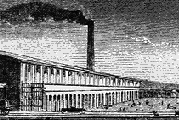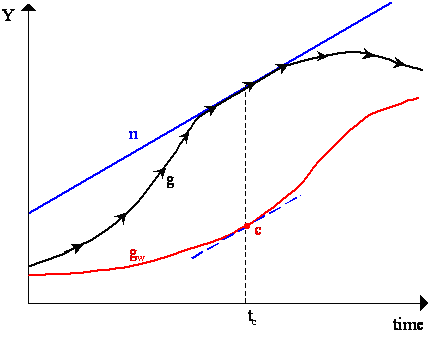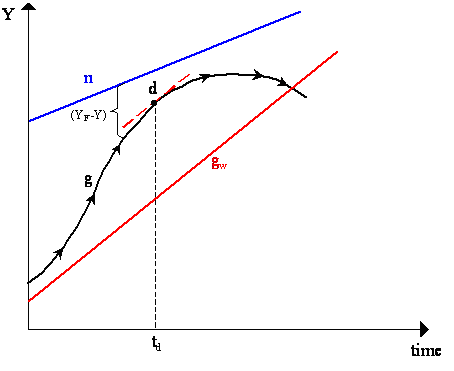|
________________________________________________________ But this is still not the end of the story. Harrod proceeds to consider the possibility that the propensity to save might change as a result of growth. He argues that when income increases, then it is probable that the propensity to save will increase as a result. In other words, if g > gw, then s might rise and when g < gw, then s might fall. The reasoning for the adjustment is a primitive form the permanent income hypothesis that was later made famous by Milton Friedman (1955). Harrod's analysis is prescient: "Even if saving as a fraction of income is fairly steady in the long run, it is not likely to be so in the short run. There is some tendency for saving in the short period to be a residual between earnings and normal habits of consumption. Companies are likely to save a large fraction of net receipts. Thus even if [gw] is normally below [n] it may rise above it in the later stages of an advance and, if it does so, a vicious spiral of depression is inevitable when full employment is reached." (Harrod, 1948: p.89). A summary version of Harrod's argument is depicted in Figure 6. We have chosen arbitrary reaction lags and the picture could look quite different if we made different assumptions about these. We begin with gw < n, so we have the conditions for a sustained boom. At the start of our trajectory, g > gw and so we know that the Harrodian instability dynamics will drive actual growth, g, further away from gw. However, following Harrod's permanent income hypothesis, as g > gw, then the propensity to save, s, will rise and, consequently, gw will rise gently. Once actual growth hits the full employment barrier, then g = n. But in the meantime, warranted growth, gw, driven by the permanent income hypothesis, will eventually catch up to it. In Figure 6, this happens at time tc (when gw = n). If, by the momentum of the chase, gw continues to rise, then we have a situation where gw > n (= g). As after time tc, gw > g, then the Harrodian instability dynamics go into reverse and g begins to fall. As the gap the gap (g - gw) becomes ever more negative, then the marginal propensity to save declines and thus gw will slow down and begin to chase g on its downward trajectory.
Another ceiling Harrod contemplates is what he calls "mobility difficulties". Specifically, he posits that, in a situation of boom, as actual growth approaches the full employment barrier, it begins to slow down because of "the increasing difficulty of transferring labour and other resources to their required uses as employment gets better" (Harrod, 1948: p.89-90). A possible result of this is shown in Figure 7. We begin with gw > n, but also have it that g > gw, so we have a boom as g pulls further away from gw. However, as the unemployment gap (YF - Y) narrows, then mobility difficulties begin to kick in and actual growth, g, slows down. In Figure 7, by time td, actual growth has slowed down enough for gw to catch up with it (gw = g at point d). Again, the momentum of g's slowing down pushes g down further, so now g < gw and the traditional Harrodian dynamics will now set themselves into reverse and drive the economy into a depression. Notice that with mobility difficulties, the upper point of the cycle is turned before full employment is hit.
While we have at least two candidates for "ceilings" for the business cycle, what about floors? What stops a recessionary spiral? Harrod posits that capital depreciation -- or necessary "replacement" investment -- will place a floor on the downswing of the cycle. In a downswing, output may be declining, but output still has to be produced. If depreciation is destroying fixed capital steadily over time, at some point some investment is necessary to keep some capital intact and enable firms to produce the desired output. As the momentum of depreciation continues pushing the volume of existing capital stock downwards, the required replacement investment increases. Firms need to investment more in order to meet their (admittedly low) expectations. So the warranted rate of growth adjusts, that is, v falls, gw begins to fall, putting a full stop to the instability. Again, the momentum of depreciation continues raising the required investment and turns it back into an upswing.
If depreciation is destroying fixed capital, firms may decide not to replace them. have to at least In a downswing, g = s/va > 0 as long as va = I/DY > 0, i.e. actual investment and output changes are moving in the same direction. becomes negative, which is brought about by the fact that va = Ia/DY < 0, actual investment is negative. However, investment cannot be negative forever. At some point, there must at least be replacement investment to maintain output. g = sDY/Ia < 0. Why does v change? g = s/va and gw = s/v, where va = Ia/DY and v = I/DY. As recession continues, I has to pick up. v falls so v < va. I < 0 In a recessionary spiral, gw > g, which implies that s/v > s/va or v = I/DY < Ia/DY = va, where I is planned investment and Ia is actual investment. Because actual investment exceeds planned investment, then by the Harrodian dynamics, entrepreneurs will continue to reduce their investment plans further. However, let us divide investment into two components: induced investment and replacement investment. So, total (or gross) investment is: It = v(Yt - Yt-1) + dYt where d is a parameter (related to the level of income) denoting depreciation rate. The first portion v(Yt - Yt-1) is induced investment, in a recessionary spiral, will be reduced to zero and even become negative. In sum, Roy Harrod (1948: p.91; also 1960, 1973) stipulates that there are two essential and potentially problematic relationships: (1) the divergence of g from gw (what we call "macroeconomic stability" and what he called "the trade cycle problem") and (2) the divergence of gw from n (what we call "employment stability" or what he calls "the problem of chronic unemployment"). The so-called Harrodian "knife-edge" problem relates solely to the first relationship. His concern with the second relationship was largely limited to how it affected the dynamics of the trade cycle by constraining g (as shown, e.g. in Figure 5) or purely as a question of economic policy (e.g. how to close the unemployment gaps of Figures 2 and 3).
|
All rights reserved, Gonšalo L. Fonseca



